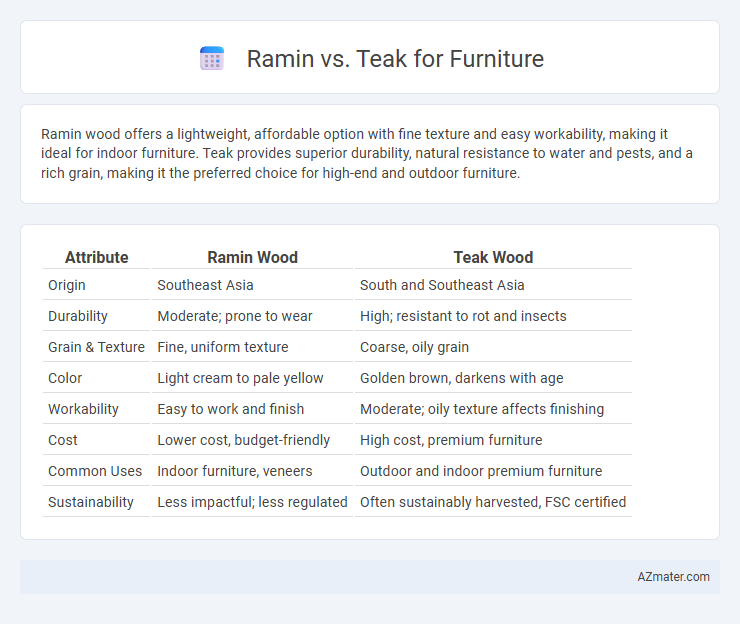Ramin wood offers a lightweight, affordable option with fine texture and easy workability, making it ideal for indoor furniture. Teak provides superior durability, natural resistance to water and pests, and a rich grain, making it the preferred choice for high-end and outdoor furniture.
Table of Comparison
| Attribute | Ramin Wood | Teak Wood |
|---|---|---|
| Origin | Southeast Asia | South and Southeast Asia |
| Durability | Moderate; prone to wear | High; resistant to rot and insects |
| Grain & Texture | Fine, uniform texture | Coarse, oily grain |
| Color | Light cream to pale yellow | Golden brown, darkens with age |
| Workability | Easy to work and finish | Moderate; oily texture affects finishing |
| Cost | Lower cost, budget-friendly | High cost, premium furniture |
| Common Uses | Indoor furniture, veneers | Outdoor and indoor premium furniture |
| Sustainability | Less impactful; less regulated | Often sustainably harvested, FSC certified |
Introduction: Why Compare Ramin and Teak for Furniture?
Ramin and Teak are two popular hardwoods widely used in furniture making due to their durability and aesthetic appeal. Comparing Ramin and Teak is essential for buyers and manufacturers seeking the best balance of cost, strength, and weather resistance. Understanding the unique properties of Ramin's light color and fine grain versus Teak's natural oils and rich texture helps make informed decisions tailored to specific furniture needs.
Botanical Overview: Ramin and Teak Explained
Ramin (Gonystylus spp.) is a tropical hardwood native to Southeast Asia, valued for its pale yellow to light brown color, fine grain, and smooth texture, making it ideal for intricate furniture detailing. Teak (Tectona grandis), originating from South and Southeast Asia, is renowned for its durability, rich golden-brown hue, and natural oils that resist water and pests, ensuring long-lasting outdoor and indoor furniture. Both woods belong to different botanical families--Ramin to Thymelaeaceae and Teak to Lamiaceae--contributing distinct characteristics to their use in furniture manufacturing.
Appearance and Color Differences
Ramin wood features a pale yellow to light reddish-brown color with a consistent grain pattern, offering a smooth and uniform appearance ideal for sleek furniture designs. Teak presents a rich golden to medium brown hue with darker streaks, providing a more textured and luxurious look that ages to a beautiful silver-gray patina over time. The distinct color contrast and grain patterns between Ramin and Teak influence furniture aesthetics, with Ramin offering brightness and subtlety, while Teak delivers warmth and depth.
Durability and Lifespan Comparison
Teak wood is renowned for its exceptional durability and lifespan, often exceeding 50 years due to its high natural oil content that resists moisture, decay, and insect damage. Ramin wood, while moderately durable and commonly used for indoor furniture, has a shorter lifespan of around 10-15 years and is more susceptible to wear and environmental damage. Choosing teak over ramin ensures long-term furniture resilience, especially in outdoor or high-humidity environments, due to its superior strength and weather resistance.
Resistance to Pests and Decay
Ramin wood offers moderate resistance to pests and decay but generally requires treatment to enhance its durability in outdoor or humid environments. Teak is renowned for its exceptional natural resistance to termites, fungi, and rot due to its high oil content and dense grain, making it ideal for long-lasting furniture. For furniture exposed to harsh conditions, teak provides superior longevity and minimal maintenance compared to ramin.
Workability and Ease of Crafting
Ramin wood features a fine, uniform texture and straight grain, making it highly workable and easy to machine, carve, and finish, which is ideal for detailed furniture crafting. Teak, while durable and resistant to moisture, has a coarser grain and natural oils that can make it tougher to work with hand tools, requiring pre-drilling and careful handling during joinery. For intricate furniture designs requiring smooth finishes and precise cuts, Ramin offers greater ease of crafting compared to the denser, oil-rich Teak.
Environmental Impact and Sustainability
Ramin wood, sourced from Southeast Asian rainforests, often suffers from overharvesting and illegal logging, leading to significant environmental degradation and loss of biodiversity. Teak, while also a tropical hardwood, is frequently cultivated in managed plantations with sustainable practices that help reduce deforestation and support carbon sequestration. Choosing certified teak furniture reduces the environmental footprint compared to ramin, whose supply chain frequently lacks proper sustainability oversight.
Cost and Market Availability
Ramin wood generally costs less than teak, making it a budget-friendly option for furniture manufacturing. Teak commands higher prices due to its superior durability, weather resistance, and oily texture that repels pests. While teak is widely sought after in premium furniture markets, ramin enjoys better market availability and faster replenishment rates, especially in Southeast Asia.
Best Uses for Ramin vs. Teak in Furniture Design
Ramin wood is ideal for lightweight indoor furniture and intricate carvings due to its smooth texture and ease of workability, making it perfect for decorative chairs, tables, and cabinetry. Teak, renowned for its natural oils and high durability, excels in outdoor furniture and high-end pieces that require resistance to moisture, insects, and weathering. While teak supports longevity in exposed environments, ramin offers a cost-effective alternative for elegant interior designs without sacrificing structural integrity.
Conclusion: Selecting the Right Wood for Your Furniture Needs
Ramin wood offers a lighter color and smooth texture ideal for indoor furniture with moderate durability needs, while teak provides exceptional strength, natural oils for water resistance, and longevity suited for outdoor or high-use pieces. Choosing between ramin and teak depends on the furniture's intended environment, budget considerations, and desired aesthetic, with teak often commanding a higher price due to its premium qualities. For lasting investment and weather resilience, teak stands out, whereas ramin suits cost-effective, decorative indoor applications.

Infographic: Ramin vs Teak for Furniture
 azmater.com
azmater.com